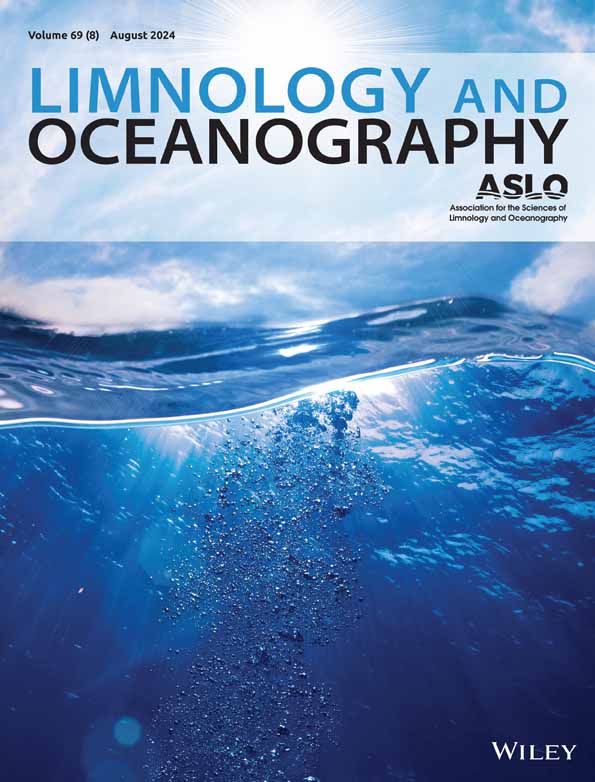波浪和剪切流中粒子优先取向引起的光衰减:细菌、藻类和微塑料的理想模型
IF 3.7
1区 地球科学
Q1 LIMNOLOGY
引用次数: 0
摘要
粒子对光的衰减是水生光气候的重要组成部分。在水面附近,波浪和剪切流可以诱导非球形粒子的优先取向,从而改变其固有的光学特性和相关的光衰减。本模型研究的重点是粒子形状和相应的优先取向如何影响水生环境中的光气候。我们假设水生颗粒,如细菌、藻类和微塑料污染物,在光学上是均匀的球体,随着水流移动。该模型计算了在线性水波和剪切流驱动下,它们在上层水柱内的优先取向。结合反常衍射光学近似来研究粒子取向对光束衰减系数的影响。我们发现,与随机(各向同性)取向相比,波和剪切的优先取向倾向于增加球体的投影面积。这对光衰减具有粒径依赖效应:对于尺寸和形状与藻类或微塑料相当的颗粒,优先取向对应于光束衰减系数增加10-25%,而对于尺寸与细菌相当的较小颗粒,光束衰减系数减少10-20%。总的来说,我们的研究结果揭示了波浪和水流对非球形颗粒的优先取向如何影响上层水柱的光气候。本文章由计算机程序翻译,如有差异,请以英文原文为准。
Light attenuation due to preferential orientation of particles in waves and shear flow: Idealized modeling for bacteria, algae, and microplastics
Particles are a key component of aquatic light climate due to their attenuation of light. Near the water surface, waves and sheared currents can induce a preferential orientation of nonspherical particles that alters their inherent optical properties and the associated light attenuation. This modeling study focuses on how particle shape, and the corresponding preferential orientation, impacts the light climate in an aquatic environment. We assume aquatic particles, such as bacteria, algae, and microplastic pollutants, are optically homogeneous spheroids that move with the flow. The model computes their preferential orientations within the upper water column in flow driven by linear water waves and sheared currents. This is combined with the anomalous diffraction optical approximation to examine the effect of particle orientation on the beam attenuation coefficient. We find that the preferential orientation by waves and shear tends to increase the projected area of the spheroid compared to random (isotropic) orientation. This has particle size‐dependent effects on light attenuation: for particles comparable in size and shape to algae or microplastics, the preferential orientation corresponds to an increase of 10–25% in the beam attenuation coefficient, whereas there is a decrease of 10–20% in the beam attenuation coefficient for smaller particles comparable in size to bacteria. Overall, our results reveal how preferential orientation of nonspherical particles by waves and currents can impact light climate in the upper water column.
求助全文
通过发布文献求助,成功后即可免费获取论文全文。
去求助
来源期刊

Limnology and Oceanography
地学-海洋学
CiteScore
8.80
自引率
6.70%
发文量
254
审稿时长
3 months
期刊介绍:
Limnology and Oceanography (L&O; print ISSN 0024-3590, online ISSN 1939-5590) publishes original articles, including scholarly reviews, about all aspects of limnology and oceanography. The journal''s unifying theme is the understanding of aquatic systems. Submissions are judged on the originality of their data, interpretations, and ideas, and on the degree to which they can be generalized beyond the particular aquatic system examined. Laboratory and modeling studies must demonstrate relevance to field environments; typically this means that they are bolstered by substantial "real-world" data. Few purely theoretical or purely empirical papers are accepted for review.
 求助内容:
求助内容: 应助结果提醒方式:
应助结果提醒方式:


